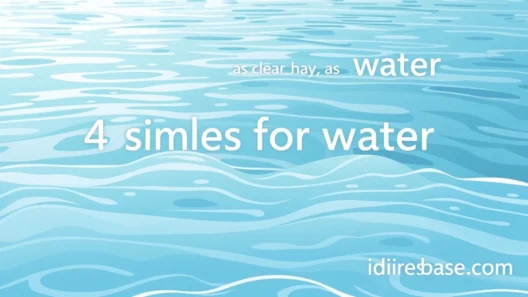You know that feeling when a smile just lights up a room? Or when someone's grin is so infectious, you can't help but smile back? Smiles are truly magical! They're a universal language, a signal of warmth, joy, and connection. But how do we describe them in a way that truly captures their essence? That's where similes come in!
Similes are fantastic tools that help us make our language more vivid and relatable. They compare two different things using "like" or "as," creating a clear and imaginative picture in your mind. Today, we're diving into the wonderful world of smiles and exploring 40 different ways to describe them using similes. Get ready to sprinkle some extra sparkle into your descriptions!
Why Similes for Smiles?
Think about it: a simple "She smiled" is okay, but "Her smile was like a sunrise" paints a much more beautiful picture, doesn't it? Similes add depth, emotion, and a touch of poetry to our writing and conversations. They help us convey the quality of a smile – whether it's shy, radiant, mischievous, or comforting.
Using similes also shows your creativity and makes your descriptions much more memorable. It helps your audience truly feel the emotion you're trying to convey.
40 Similes for Smile
Let's explore these wonderful ways to describe that beautiful expression!
- Her smile was as bright as sunshine. (Evokes warmth and radiance)
- His grin was like a beacon in the dark. (Suggests hope and guidance)
- Her smile spread like butter on warm toast. (Implies a slow, comforting spread)
- He smiled as wide as a crescent moon. (Highlights the shape and perhaps a hint of mystery)
- Her smile was like a blooming flower. (Conveys beauty, freshness, and opening up)
- His smile was as sweet as honey. (Suggests kindness and pleasantness)
- Her smile sparkled like a diamond. (Indicates brilliance and preciousness)
- His smile was like a fresh spring morning. (Evokes new beginnings and pleasantness)
- Her smile danced like a butterfly. (Suggests lightness, playfulness, and fleeting beauty)
- His smile was as comforting as a warm blanket. (Implies solace and security)
- Her smile was like a secret whispered. (Suggests intimacy, mystery, and a shared moment)
- His smile was as quick as a flash of lightning. (Indicates suddenness and perhaps surprise)
- Her smile was like ripples in a pond. (Suggests a gentle, spreading effect)
- His smile was as gentle as a feather. (Conveys softness and delicacy)
- Her smile was like a hidden treasure. (Implies rarity, value, and a sense of discovery)
- His smile was as golden as a sunset. (Evokes warmth, beauty, and a sense of grandeur)
- Her smile was like a melody. (Suggests harmony, pleasantness, and perhaps a catchy quality)
- His smile was as clear as a bell. (Indicates sincerity and transparency)
- Her smile was like a soft whisper of wind. (Conveys lightness, subtlety, and a fleeting presence)
- His smile was as inviting as an open door. (Suggests welcome and approachability)
- Her smile was like a morning dewdrop. (Implies freshness, purity, and sparkle)
- His smile was as wide as the ocean. (Suggests vastness, depth, and boundless joy)
- Her smile was like a quiet stream. (Conveys peacefulness and gentle flow)
- His smile was as sharp as a newly sharpened pencil. (Suggests a clever, perhaps mischievous edge)
- Her smile was like a light switch flipping on. (Indicates sudden illumination and cheer)
- His smile was as rare as a blue moon. (Suggests infrequency and specialness)
- Her smile was like a warm hug. (Evokes comfort, affection, and reassurance)
- His smile was as natural as breathing. (Implies effortlessness and authenticity)
- Her smile was like a burst of fireworks. (Suggests excitement, brilliance, and a grand display)
- His smile was as mischievous as a cat's. (Conveys playfulness and a hint of naughtiness)
- Her smile was like a calm harbor. (Implies peace, safety, and a sense of belonging)
- His smile was as infectious as a yawn. (Suggests rapid spreading and irresistibility)
- Her smile was like a gentle wave. (Conveys calmness, rhythm, and a soothing quality)
- His smile was as steady as a lighthouse beam. (Implies reliability and guidance)
- Her smile was like a freshly baked cookie. (Evokes warmth, comfort, and deliciousness)
- His smile was as deep as a well. (Suggests profound emotion or hidden meaning)
- Her smile was like a sigh of relief. (Conveys release from tension and comfort)
- His smile was as sharp as a fox. (Suggests cleverness, cunning, and intelligence)
- Her smile was like a painting. (Implies artistry, beauty, and careful construction)
- His smile was as vast as the sky. (Suggests expansiveness and limitless potential)
How to Choose the Perfect Simile
With so many options, how do you pick the best one? It's all about context and the specific emotion you want to convey.

Consider the Emotion
- Joyful/Radiant: "as bright as sunshine," "like a blooming flower"
- Warm/Comforting: "as sweet as honey," "as comforting as a warm blanket," "like a warm hug"
- Shy/Subtle: "like a secret whispered," "like a soft whisper of wind"
- Mischievous/Clever: "as sharp as a fox," "as mischievous as a cat's"
- Surprising/Sudden: "as quick as a flash of lightning," "like a light switch flipping on"
Think About the Character
Is the person generally shy or outgoing? Are they known for their wisdom or their playful nature? A simile should fit the character you're describing.
Visualize the Scene

What's happening around the smile? Does it fit the overall mood of the moment? A "burst of fireworks" smile might not be right for a somber scene.
Key Takeaways
- Similes are powerful literary devices that compare two unlike things using "like" or "as."
- They add vividness, emotion, and creativity to your descriptions, especially when talking about smiles.
- Choosing the right simile depends on the emotion you want to convey, the character, and the context of the scene.
- Practicing with different similes can greatly enhance your writing and communication skills.
Frequently Asked Questions (FAQ)
Q1: What is a simile?

A simile is a figure of speech that directly compares two different things, usually by using the words "like" or "as." Its purpose is to make a description more vivid, imaginative, or emphatic. For example, saying "The clouds were like cotton candy" helps you visualize soft, fluffy clouds.
Q2: How do similes differ from metaphors?
Both similes and metaphors are figures of speech that make comparisons, but they do so in different ways. A simile states that one thing is like another (e.g., "Her smile was like a sunrise"). A metaphor, on the other hand, directly states that one thing is another, without using "like" or "as" (e.g., "Her smile was a sunrise"). Metaphors create a stronger, more direct identification between the two things.
Q3: Why are similes important in writing?
Similes are incredibly important because they add depth, color, and sensory detail to writing. They help readers visualize scenes, understand complex emotions, and connect with the text on a deeper level. By comparing something familiar to something less familiar (or vice-versa), similes make descriptions more relatable and memorable. They also showcase the writer's creativity and command of language.
Q4: Can I create my own similes?
Absolutely! Creating your own similes is a fantastic way to develop your writing skills and express yourself uniquely. To create one, think of the quality you want to describe (e.g., how bright a smile is). Then, brainstorm other things that possess that same quality (e.g., the sun, a lamp, a star). Finally, connect them using "like" or "as" (e.g., "Her smile was as bright as a supernova"). The more imaginative your comparison, the more impactful your simile will be!
Q5: Are there any common mistakes to avoid when using similes?
Yes, there are a few things to watch out for:
- Overuse: Don't use too many similes in one place, as it can make your writing feel forced or clunky.
- Clichés: Avoid using overused similes (e.g., "as busy as a bee") unless you're intentionally playing on them. Strive for originality.
- Inappropriate comparisons: Make sure your comparison makes sense and enhances the meaning, rather than confusing the reader (e.g., "His smile was like a brick" might be confusing unless you intend it to be harsh or unyielding).
- Redundancy: Ensure the simile adds new information or a deeper understanding, rather than just restating something obvious.
Keep these tips in mind, and you'll be crafting vivid, engaging descriptions in no time!
We hope this list gives you plenty of inspiration for describing those wonderful moments of joy and connection. A smile is truly one of the most beautiful expressions, and now you have 40 amazing ways to capture its magic! So go forth, and make your descriptions shine!





